Behind the Data
Occupational Pension Funds in Ireland: What do we know?
Kenneth Devine, David Mulleady and Ciarán Nevin *
January 2021
New data on occupational pension funds highlight concentrated holdings of investment funds and unit-linked insurance products. The impact of COVID-19 is evident in the volatile asset values, which sit 1.8 per cent below pre-pandemic levels.
Introduction
Pensions have a key role in the economy, acting as the primary source of income to households in retirement and facilitating the long-term allocation of capital across economic sectors. They represent an important part of household wealth, and are comparable to mortgages in terms of significant lifetime financial decisions. As outlined by the OECD (2020), pension systems already faced challenges with aging populations, the low interest rate environment and the prevailing low yields on safe assets. The transition of pensions from defined benefit (DB) to defined contribution (DC) also means households are increasingly exposed to financial market shocks. The financial market volatility and economic shock associated with COVID-19 have compounded these issues.
The Irish pension system includes pensions provided by the State, employers and those purchased privately by individuals. While previous work by the OECD (2014) provided a comprehensive review of the Irish pension system, its analysis of occupational pension funds was constrained by a lack of granular, harmonised data. New Central Bank of Ireland statistics covering occupational pension funds help to fill this gap by providing a better understanding of the structure and asset holdings of the sector.
This “Behind the Data” (BTD) presents an overview of the occupational pension fund sector in Ireland since Q3 2019. It discusses the role of occupational pension funds as a household asset, outlines the breakdown of financial assets, and examines the impact of the pandemic on these holdings.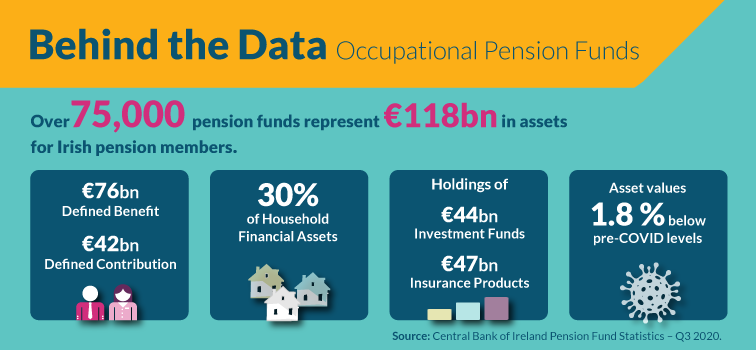
Overview of the Irish Pension Fund Sector
Pension systems can be categorised into three pillars. Pillar 1 is the state pension, whose primary aim is to provide a basic level of income. Pillar 2 consists of occupational pension funds. Occupational pension funds are sponsored by employers and are either DB – where the risk is borne by the sponsor, DC – where the risk is borne by the pension holder, or a hybrid of DB and DC. Finally, Pillar 3 is made up of personal pensions including Personal Retirement Savings Accounts (PRSAs) and Retirement Annuity Contracts (RACs). The combination of income from these three pillars represents the primary means through which households finance themselves in retirement.
This BTD focuses on Pillar 2 - occupational pension funds. The implementation of the European Central Bank Regulation on statistical reporting requirements for pension funds provides new granular data, offering increased transparency on assets and the structure of the sector. In June 2020, Irish occupational pension funds had assets of €118 billion accounting for 30 per cent of household financial assets. This is the second largest household financial asset behind currency and deposits (Chart 1). Household sector housing assets accounted for €542 billion in the same period. To compare Pillar 2 with the other pillars, PRSA assets, a primary component of Pillar 3 pensions, amounted to €7.3 billion at Q2 2020. In 2018, Government expenditure on the pay-as-you-go state pension was €6.2 billion.
Chart 1: Irish Household Sector Financial Assets
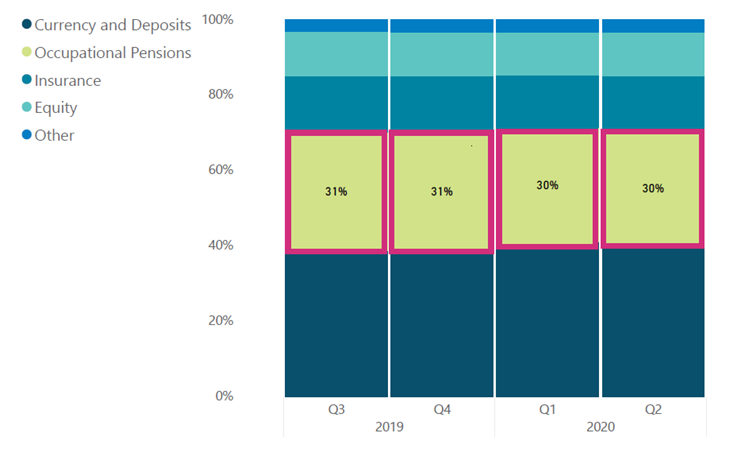
Source: Quarterly Financial Accounts and Central Bank of Ireland calculations
Notes: Pillar 1 social security government pensions are not included unless saved as deposits. Pillar 3 pension products provided by insurance corporations are captured under Insurance. Other category includes securities, investment fund shares and other accounts receivable/payable.
According to the Pensions Authority’s 2019 annual report, Pillar 2 in Ireland consists of over 75,000 active occupational pension funds, representing almost half a million active members. This represents over 90 per cent of total euro area pension funds by number. Some countries have as few as eight pension funds. The size, and role, of Pillar 2 pensions varies across euro area countries (Curos et al., 2020), with total assets of the pension fund sector amounting to €3 trillion at September 2020. The occupational pension fund sector in the Netherlands is an outlier in the euro area, with total assets worth 215 per cent of the country's Gross Domestic Product (GDP). This may be explained by high replacement rates and mandatory private pensions (OECD, 2014), along with a greater share of pension income being derived from Pillar 2 (Curos et al., 2020). The relative size, and importance, of its first pillar would be smaller in comparison with other countries. The next largest is Ireland at 56 per cent of Gross National Income* (GNI*) (or 34 per cent of GDP). This highlights the importance of the sector relative to these economies.
Chart 2: Pension fund assets as a percentage of country GDP at end-2019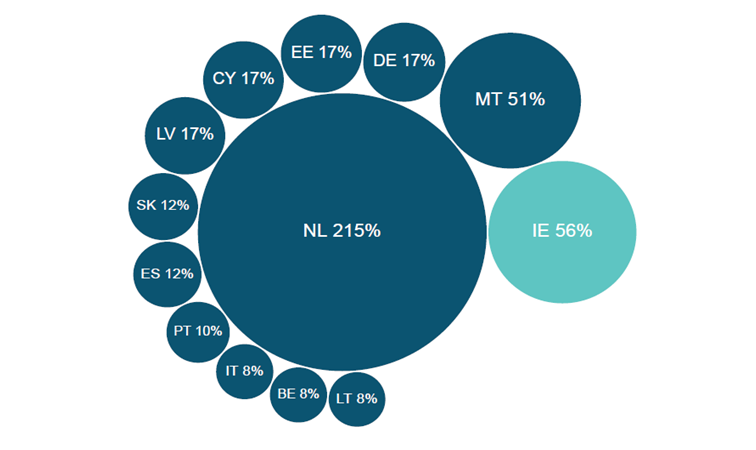
Source: Eurostat, European Central Bank and Central Bank of Ireland calculations
Notes: GNI* measurement is used for IE.
There are 74,866 DC and 597 DB active funds in the Irish pension fund sector. Funds are overseen by trustees and range from a few very large funds with 5,000 active members and billions of euro in assets to a significant number of very small funds with a single member and assets in the thousands of euro. The top ten pension funds account for approximately 30 per cent of the sectors assets. The large number of remaining funds, unique to Ireland, are primarily made up of small self-administered schemes and are usually single member arrangements. These schemes offer individuals more flexibility and control over investment assets. This heterogeneity of scheme structures poses challenges when assessing sector risks.
DB pension funds account for two thirds of assets in the sector (€76 billion) but the greater share of active members are in DC pension funds. In recent years, the Pensions Authority has indicated a transition away from DB funds (fall of 50 per cent in number of active schemes since end-2009). As such, many DB funds are now closed to new members as employers face higher costs, and underfunding challenges compounded by a low interest rate environment. In a DB pension fund, any shortfall in funding must be met through increased contributions to avoid a reduction in promised benefits. Conversely, for DC pension funds, the member's income in retirement is dependent on asset performance. The structural change from DB to DC pension funds has shifted investment risk from the corporate sector to households (Brown, 2016). Households, and their retirement income, are now increasingly exposed to financial market shocks, as any fall in asset values will directly reduce the value of their pensions.
Asset Breakdown of Pension Funds
Irish pension funds primarily invest in investment funds (IFs) shares and unit-linked insurance products (ULIPs). The latter are statistically classified as pension fund reserves (Chart 3). ULIPs are issued by insurance corporations and are similar to IFs, with the unit value increasing or decreasing as the market value of underlying assets change. Combined, these two instruments account for three quarters of the sector’s balance sheet. Such products can invest in a wide range of assets on behalf of the fund members and this enables pension funds to diversify their investment holdings indirectly. Direct holdings of financial instruments and property represent a smaller proportion of the sector’s investment activity. Where funds do hold the instruments directly, these tend to be debt securities.
However, structural differences in asset holdings do exist across DB/DC pension funds in terms of both the type of financial assets held and the number of distinct, direct investments. While the larger DB pension funds can be seen to directly invest in hundreds of diverse assets including equities and debt securities, smaller DC pension funds tend to predominantly hold a limited number of investments in IFs and ULIPs.
Between Q3 2019 and Q3 2020, the structure of pension fund asset holdings remained relatively stable. Given the concentration of holdings in IFs and ULIPs, particularly for DC pension funds where households face greater investment risk , future work will seek to further explore the interconnectedness of these assets across the pension fund, insurance corporation and IF sectors.
Chart 3: Pension fund asset structure year-on-year comparison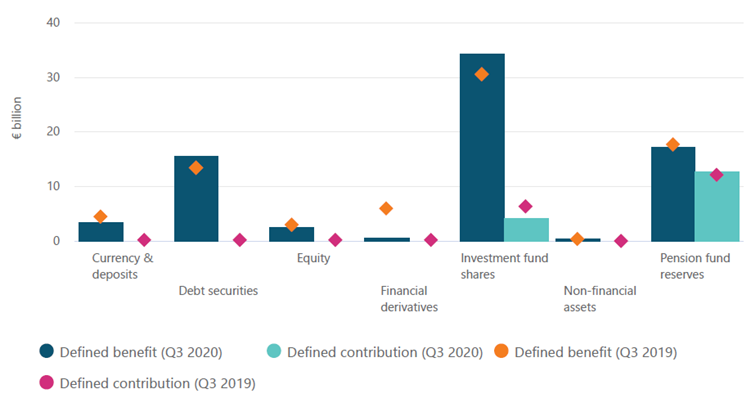
Source: Central Bank of Ireland calculations
Notes: Data covers detailed reporting population representing at least 75 per cent of assets in the sector. Pension fund reserves include ULIPs.
Impact of COVID-19 on Asset Values
Following the onset of the COVID-19 pandemic, the total value of pension fund assets declined in Q1 2020. This included decreases for both DB (5.2 per cent) and DC (8.9 per cent), a proportionally greater fall for pension funds in which households bear the risk. These asset values largely recovered across Q2 and Q3 2020 to sit at €118 billion. The movements were predominantly caused by financial market price gains and losses as the pandemic, and global policy responses evolved. The positive inflows in Q1 2020 can be associated with an increase in holdings of safer assets, such as currency and deposits.
Following the beginning of the pandemic, IF and ULIP holdings fell for both DB and DC pension funds. The value of ULIPs remain below pre-COVID levels for both DC and DB funds. While DB IF holdings have fully recovered, DC IF assets still sit below end-2019 values.
Chart 4: Impact of COVID-19 on Pension Fund Asset Prices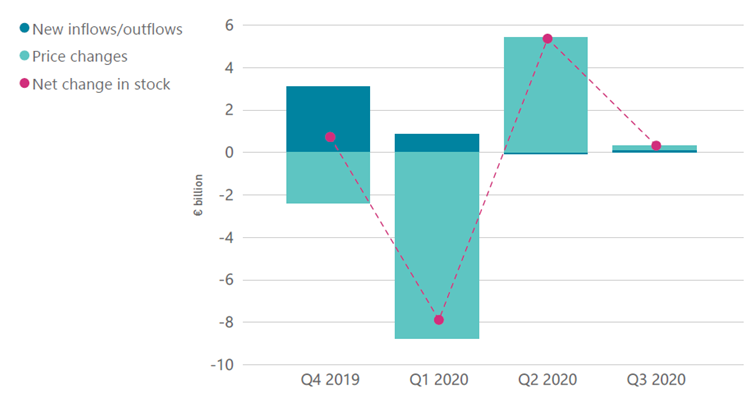
Source: Central Bank of Ireland calculations
While the onset of the COVID-19 pandemic caused a decline in pension fund asset values, they have largely recovered to sit at 1.8 per cent below pre-pandemic levels.
Conclusion
Using enhanced, granular data, this BTD presents insights into occupational pension funds in Ireland. It provides an overview of the unique structure of the sector, identifying the large number of entities that exist and where the concentration of assets lie. The increasing dominance of DC pension funds leaves households more exposed to financial market movements. Utilising new statistical data, the impact of COVID-19 up to Q3 2020 is assessed, and while pension fund assets experienced a sharp price fall of €8 billion, they have since recovered to sit at 1.8 per cent below pre-pandemic levels. This piece outlines the varying composition of financial asset holdings with differences evident across pension fund type. In addition to the Central Bank publishing statistical information releases on a quarterly basis, the next steps in developing this dataset will include investigating the asset breakdowns by their sector and geography to further explore these household investment exposures.
*Email [email protected] if you have any comments or questions on this note. The authors extend their thanks to Colleen Stewart for her work on the data collection. Comments from Reamonn Lydon, Mark Cassidy, Caroline Mehigan, Sharon Donnery, Tim O’Hanrahan, Maria Woods, Rory McElligott and Jenny Osborne-Kinch are gratefully acknowledged. The views expressed in this note are those of the authors and do not necessarily reflect the views of the Central Bank of Ireland or the ESCB.
See also: